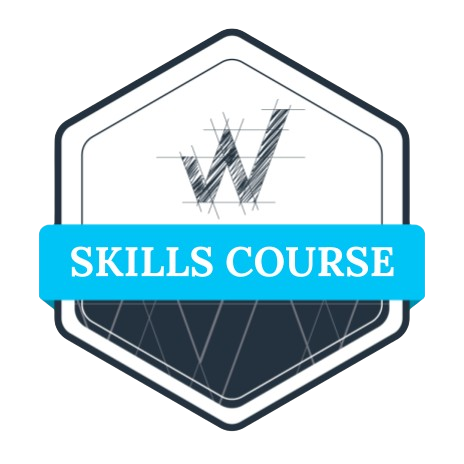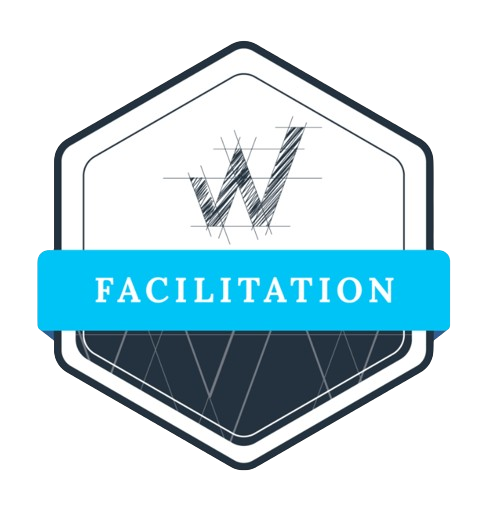Companies at every phase of growth will require a cohesive, integrated technology tool stack to assist and streamline sales organizations and other teams. While there are many tools available in the form of platforms, applications, and outsourced services, it is important to determine which ones are necessary at each phase of growth and learn how to select them.
Common Technology Tool Stack Options
The tool stack that a company selects should be just as strategic as the organization and the processes it supports. For all of the various tools that a team will need, there are thousands of options to choose from. The process of selecting, purchasing, and integrating the components of your company’s tool stack can be overwhelming.
In general, the most common options are the following:
Salesforce-Based Infrastructure. Salesforce (SFDC) is most commonly used as a CRM (customer relationship management software) by companies that have an annual contract value of $15,000 or more. Companies using SFDC often sell a platform product with a longer sales cycle that requires a more robust toolset. All of the SFDC SaaS services are available in the Salesforce AppExchange.
Google-Based Infrastructure. Google (G Suite) products are commonly used by companies with early and high velocity solutions. Companies that sell applications rather than platforms tend to use G Suite infrastructure for longer periods of time before switching to SFDC. All Google-based CRM tools and applications are are all found on G Suite.
Narrowing Down Tool Stack Options
There are four key guidelines that will help you narrow down technology stack options and point your company toward an effective solution:
1 – Know the differences between the layers of the stack. There will be several different technology components involved in your tool stack, and you will need to make decisions surrounding all of them:
-
- Server: You will need servers for the operations of your business. Select from the major players: Microsoft, AWS, or Google.
- Platform: Research the different platforms – including Salesforce, Hubspot, Marketo, and Zendesk – to ensure that you select one that will allow for your company’s future needs. Once you choose a platform, it can be difficult to change in the future.
- Application: Applications can be stand-alone, fully integrated into your platform, or work side-by-side with your platform. Unlike platforms, applications can be exchanged more easily if your business needs change and grow. Calendly, Bill.com, and Zoom are all examples of applications.
- Outsourced Services: These are external services that perform an entire function for your company, like an outsourced SDR, accountant, or lead enrichment service.
2 – All tools should contribute data to the database. Many of your company’s future decisions will be data-driven, so ensure that all tools contribute data to your knowledge base. As an example, consider an email automation tool. Instead of asking your sales team if they are effectively using email, use an email tool where you can see the answer with data. Ideally, your email automation tool will automatically log all inbound and outbound emails and produce metrics on response rates and deliverability. In general, even if one tool is functionally better than another, if it does not contribute actionable data to your collective organizational database, avoid it.
3 – Contracts for different types of technology should be treated differently. As a general rule, the following contract terms are recommended for each layer of the tool stack:
-
-
- Server: This is the infrastructure you are building upon.
- Platforms: After a one-year initial contract, if the platform suits your company’s needs, you should feel comfortable signing a multi-year commitment.
- Applications: Contract for a maximum term of 12 months, and then renew annually.
- Services: Services should have contracts based on usage or impact. Make commitments of no more than three months at a time.
-
4 – All functions need to be supported by tools, but keep it balanced. Every function needs some amount of tooling in order to scale. However, you should avoid giving the marketing department too many tools while failing to support areas such as customer success. The more tools you acquire, the more manpower your company will need to manage and administer these tools and interpret the data and insights that they provide. Strike a balance between tools and human brain power.
Recommended Sales Tool Stacks at Each Growth Phase
When choosing which tools to purchase, rather than undertaking a serious vetting and selection process, many companies simply want to know which tools are the best. But the needs of every business are different, so that answer will change depending on your circumstances. For that very reason, there are thousands of different tools with different capabilities and feature sets available.
The list of resources below is merely an overview. These tools may not work for every business, however, they are a good starting point to help you evaluate your company’s options and make a selection based on what fits your business needs. New solutions are being released all the time, and point solution tools are being acquired by larger companies every year, so do not consider this list to be conclusive or exhaustive. Rather, this is a high-level baseline for the tools that a company will need at each phase of growth.

Tools for Phase 1: Start Up
Companies in the Start Up phase only have a few sales reps, so they should not overburden themselves with too many tools. As a guideline, your company should do as much as possible with simple spreadsheets and supplement with a few powerful tools. Enable prospecting with tools like LinkedIn Navigator, MixMax, and Calendly. For most other needs, use manual or spreadsheet substitutes.
Google G Suite: Most Start Up companies will use Google G Suite to begin building a tool stack. G Suite is simple, relatively low cost, and strong in sharing capabilities. It provides cost-effective access to classic office productivity products that are easy to use, and it gives teams the ability to share, edit, comment, and collaborate in real time. Consider starting with the following applications, which can operate on top of or integrate with G Suite:
ZoomInfo: Over the next few years, your company will need to build a high-quality database, which requires the use of high-quality inputs. ZoomInfo provides reliable contact information for your target prospects based on customizable parameters.
Drift*: As visits to your company website increase, you should start to build engagement with those visitors. Drift allows you to chat with visitors, and the Drift bot feature lets you quickly answer questions, book meetings, and gather insights. Implement the freemium version as early as possible.
LinkedIn*: LinkedIn is a reliable and valuable source of information for lead generation as well as understanding prospects, connections, and anyone you set a meeting with.
MixMax*: As you build a sales team, you will need to schedule meetings and calls, send templated emails, and create email cadences. MixMax offers user-friendly tools for efficient email outreach.
Zoom Conference: While in-person meetings are very valuable, they will not help you scale as efficiently as you are likely to require in the future. Get comfortable with remote meetings via Zoom video conferencing as soon as possible.
HelloSign/DocuSign*: From the outset, your company will need to maintain an electronic record of all electronically-signed documents and agreements. Use a freemium subscription of HelloSign or DocuSign until you exceed the amount of free signatures available, and then upgrade to a paid subscription. Stay with whichever provider you choose for at least a few years.
Xero: Do not attempt to send your first company invoices manually. The complexity and potential mistakes associated with financial transactions are not worth the small amount you might achieve in savings. Start using Xero immediately for your invoice needs. See below for an example of a customer-friendly invoice. At this early stage, give your direct phone number to customers so that you can quickly resolve any financial issues.
*Indicates free version available
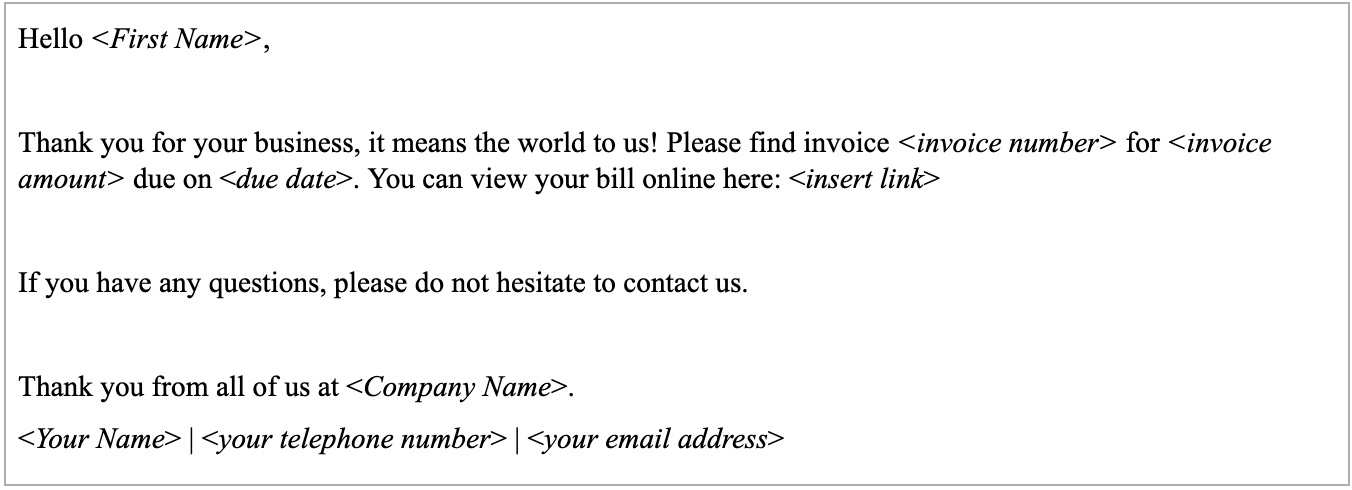
Common Pitfalls at the Start Up Phase
Pitfall #1: Committing to a large upfront payment or lengthy contract terms. Select a monthly contract first, even if it is more expensive. If the tool proves to be impactful, then upgrade to an annual/upfront contract. Do not agree to auto-renewal.
Pitfall #2: Purchasing paid subscriptions when a free version is available. This is the time to test out tools and learn which ones work best for your business and team. There will be plenty of tools that you need to purchase in the future.
Pitfall #3: Not using a paid tool for critical tasks such as document signing or web conferencing. These are critical tasks that you should not execute with free tools.
?Pitfall #4: Buying into a CRM or MAS (marketing automation system) immediately. Do not invest in an expensive subscription before you need it (e.g. when your company has less than 10 customers). Remember that you will need a consultant to implement and manage a CRM.

Tools for Phase 2: Grow Up
By the Grow Up phase, a company has outgrown its reliance on spreadsheets. This is the time to implement a lightweight CRM, enhance lead qualification with lead enrichment and analytics, and upgrade to the paid versions of some tools. The extra spend will be worth the efficiency gains as your company scales.
Platforms: In the Grow Up phase, MAS and CRM platforms become a part of your company’s tool stack. Because your business is growing, now is the time to commit to your first platforms:
-
-
- HubSpot/Pardot: For a marketing automation system, use HubSpot or Pardot to build landing pages, track content engagement, and manage newsletter-style campaigns.
- Pipedrive: Pipedrive is another popular CRM system that easily connects with Google infrastructure, though some may prefer to use Hubspot and its CRM solution.
-
Applications: For the following applications, upgrade from a free account to a paid subscription:
-
-
- Drift: Upgrading will allow you to begin using “playbooks per page,” which includes campaigns, qualification, and scheduling.
- LinkedIn: Purchasing the premium subscription (Sales Navigator) provides advanced lead search capabilities and lead recommendations.
- Zoom: This is the time to invest in a paid license and a proper Zoom-equipped conference room with integrated audio and content sharing. Phase out any casual video conferencing, e.g. at the kitchen table.
-
Outsourcing: In the Grow Up phase, your company may need to begin outsourcing certain services:
-
-
- External Accountant: Consider hiring an accounting firm to perform company invoicing and follow up on customer payments. A qualified external accountant can remotely log into your Xero account and immediately relieve you of that burden.
- Lead Enrichment: In the Start Up phase, you may have browsed websites, LinkedIn profiles, and government sites to find leads. In the Grow Up phase, this work can be outsourced using a talent platform such as Upwork. Create a screen recording with a voiceover to show and explain how you generate these leads. Share it with the person you hire so they can see and follow the process exactly.
-
If you are using a platform such as Upwork to outsource company tasks, record a short video (as described above) or create a detailed write-up to explain the work you want performed.
To find the right candidate, outsource the work to three to five people who meet your experience and location criteria, review their work after a paid trial period, and hire the person who did the best job. Ideal candidates will have excellent communication skills, both in responsiveness and style, and high-quality work product.
Common Pitfalls at the Grow Up Phase
Pitfall #1: Difficulty deciding on a tool. There are three basic areas of impact from a tool set:
-
-
- Increased effectiveness: The tool helps you win more deals. For example, tools such as Infer or Everstring.
- Increased efficiency: The tool helps you do the same amount of work with fewer resources. For example, tools like Calendly.
- Better experience: The tool improves the customer’s experience OR the operator’s experience. For example, Docusign makes it easy for the customer to execute a document, while an accounting tool like Xero or a quotation tool like Pandadoc help your team avoid entering large amounts of data.
-
If a tool provides impact in all three categories, it is a great purchase. If it provides impact in two, it is likely a good purchase. If a tool only provides impact in one of these areas, it should have a very large impact in order to justify its purchase.
Pitfall #2: There are so many options for tooling, you do not know how to choose. A/B test each of the applications you are considering over a period of one to two weeks, and then decide.
Pitfall #3: You find an excellent tool, but it does not integrate with your existing stack. Do not buy it.

Tools for Phase 3: Scale Up
In the Scale Up phase, your company now has a sizeable sales team. You will need a more robust toolset to enable your team and orchestrate more sophisticated activities. These tools will become very important as your company continues to add more sales reps at a much faster rate than it adds sales operations/enablement or sales managers. Implement tools that provide sophisticated insights and enable your team across the full customer lifecycle.
Platforms: In the Scale Up phase, your company should introduce a customer database and upgrade to industry-grade tools. The platforms and infrastructure that you implement will likely stay with your business until it reaches $50M ARR, so do your research and choose wisely:
- Customer Database: Use Salesforce. While it is expensive and can be cumbersome, it is the most scalable.
- Marketing Automation System: Choose a platform that provides detailed data on leads – the number of leads, the source of those leads, how they engaged with your company, and what content they have consumed. Inbound companies (those who sell applications) often select HubSpot, whereas outbound companies (those who sell platforms) often select Marketo.
- Customer Relationship Management: Use Salesforce (see above).
- Customer Platform: Most companies will use a combination of Zendesk, a support ticket system, and Gainsight or Totango for customer success.
Applications: Your company likely has several different teams with different needs and different requests for applications they prefer to use. Prioritize what deserves your investment. One of the keys to picking the right tool is determining whether it integrates with your data model. (For instance, will a call recording automatically be added to the customer record in your CRM, or does the sales rep need to do this manually?) Look out for seamless integrations to complete your data model:
- Cloud-Based Proposals: With tools like PandaDoc, you can build proposals, add terms and conditions, and use real-time, updated customer lists.
- Cloud-Based Phone System: At this stage of growth, your company can no longer simply use email and smartphones. Implement a phone system, 1-800 line, etc. by using a cloud provider like TalkDesk or NewVoiceMedia
- Real-Time Dashboards for Board-Level Reporting: Use reporting directly from standardized dashboards to avoid frustrating your organization at board meetings. One such solution is InsightSquared
Outsourced Services: At the Scale Up phase, consider adding extra services to cover your company’s weaknesses. Some of these services, such as consultants, may come with their own tools:
- Call Reviews or Coaching: To improve sales performance, tools like Chorus or Gong will record calls and provide analysis. These services directly integrate with Zoom calls. To analyze these recordings, you can work with an outsourced service or consultancy to perform call reviews with sales reps. This ensures your sales metrics such as ACV, win rate, and sales cycle are in the upper 10th percentile.
Common Pitfalls at the Scale Up Phase
Pitfall #1: An overload of tools. Avoid overburdening your organization with tools using a strict approval process: Any tool that involves a multi-month contract should require approval from your executive team. This is important, as every tool will require an investment of time, training, budget – or a combination of all three – from your team.
Pitfall 2: Not knowing how many SaaS tools are enough. For guidance, a company in the Start Up phase should have 10 to 20 tools, a company in the Grow Up phase should have 20 to 30 tools, and a company in the Scale Up phase should have 30 to 50 tools. (Note that these numbers are in regards to tools for the entire company, not just the sales organization.)
Pitfall 3: Acquiring tools without enough manpower to run them. You will need at least one person (potentially more) who is dedicated to Sales Operations in order to manage your tool stack. While providers may make tools seem simple or easy to “plug and play,” your company will need someone to manage the process of vetting, running pilot tests with sales reps, selecting, integrating, and managing all of your tools.
Detailed Tool Recommendations by Growth Phase
For more granular recommendations on each type of tool at each phase of company growth, see Table A.
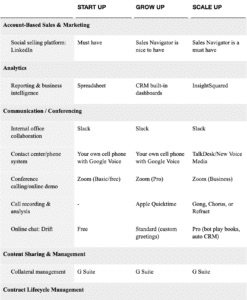
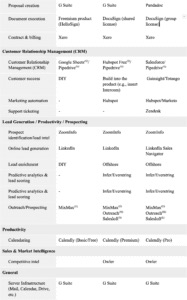
![]()
